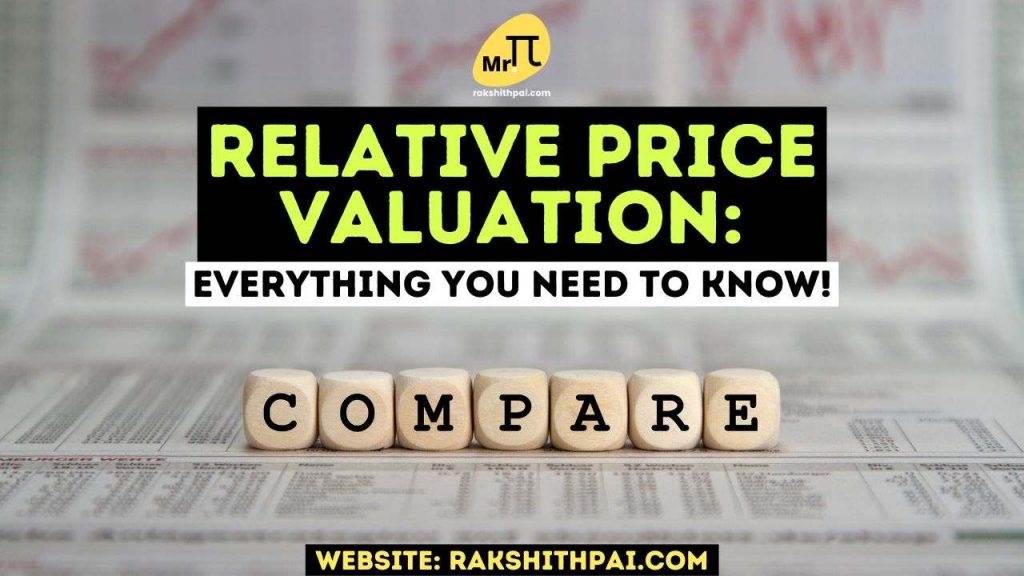Table of Contents
What Is a Relative Valuation Model?
A company’s worth can be estimated using a relative valuation model by comparing it to the worth of other companies in the same industry. Absolute value models try to calculate a company’s value by discounting its expected future free cash flows to the present, with no consideration of how similar or unlike those cash flows could be to those of other companies. Like absolute value models, relative valuation models can help investors decide if a company’s stock is worth purchasing.
By comparing it to other companies in the same industry and by the same criterion, relative valuation attempts to determine a company’s worth. The method depends on the market’s accurate assessment of comparable companies’ worth. One of the best ways to determine if a company’s stock price is fair is to compare it to similar companies.
How to do Relative Valuation?
Relative valuation as the word suggests is to value one company by comparing it to its peers. So, the following are 5 steps you need to do to compare:
Identify Peer Companies
In order to compare the peer company’s financials, you must know what is the company’s business objective and then see for similar companies with the same business objectives.
It is suggested to see for companies that are of similar size in market capitalization, with the same location of the business, similar capital structure, serve similar market base (domestic, international, or both), and such others for similarities.
Ratio Analysis
When it comes to Financial Analysis, analyzing the ratio of both the comparable companies is the best choice. Being in the same industry with similar financial figures, ratio analysis is the best choice to arrive at the decision of which company is the better choice for investment.
Following are the key ratios to consider:
Price to Earnings (P/E) ratio
The price-earnings ratio (P/E ratio, P/E, or PER) compares the current market price of a share to the company’s per-share earnings. Companies can be evaluated for their fair market worth using this ratio.
Price to Earnings Growth (PEG) ratio
The PEG ratio is a valuation statistic used to examine the relationship between a stock’s price, its earnings per share, and the growth prospects of the underlying business. A higher growth rate usually results in a higher P/E ratio.
Price to Book (P/B) ratio
The price-to-book ratio (P/B ratio) is a financial measure used to evaluate the market value of a firm relative to its book value as of a specific date. Value per share is determined by dividing the stock price by the book value of the company’s shares (BVPS).
Enterprise Value to Earnings before interests and taxes (EV/EBITDA) ratio
Analysts and investors can use it to compare businesses in the same sector. Earnings before interest, taxes, depreciation, and amortization (EBITDA) is the key figure used in determining the enterprise value-to-EBITDA ratio. It is generally accepted that an EV/EBITDA figure of less than 10 is considered good.
Price to Sales (P/S) ratio
The price-to-sales ratio (P/S ratio) is commonly used to value equities. You can figure out a company’s market capitalization by dividing its annual revenue by the price of a share of stock during its most recent trading period.
Price to Cash flows (P/CF) ratio
The price-to-cash flow (P/CF) ratio is a multiple used to examine the relationship between the market value of a firm and its operating cash flow. For valuation purposes, large non-cash expenses, such as depreciation, lend themselves well to the P/CF multiple.
Time Period
The time frame chosen should ensure that the companies being compared have been at roughly the same stage of development. A common practice in this field is to consider a longer time frame such as a 5-year time frame in which to make comparisons. However, other time periods may be acceptable if adequately explained.
Data Analysis
Once our basic requirements for comparison with another company which is a peer business that showcases similar financial performance with a similar stage of business in regards to the time period in business. We now do the data analysis to see exactly how and where the company has the upper hand or otherwise.
Financial Analysis & performance evaluation of the peer companies must be done and the same needs to be compared with the company we wish to invest in.
Intrinsic valuation
Once the comparative relative valuation is completed. We do the intrinsic valuation to evaluate the actual worth of the company with respect to what it is being quoted in the open market. There are chances when an entire industry is overvalued. This means each and every company in the business will be valued high for some economic or geopolitical reasons.
In the case of relative valuation, we realize this fact in the initial stage itself. And, when intrinsic valuation is done, we will know the actual worth of the company along with its peers and industry average.
Pros of Relative Valuations:
- Relative valuation is comparatively easy and convenient to do by any stock market beginner investors.
- A relative valuation can be done in a less time-consuming & simpler manner.
- The relative valuation required Financial Data that are easily accessible on Public platforms. Hence, it is doable by every individual.
Cons of Relative Valuations:
- A relative valuation cannot help in every industry. Some businesses are unique in nature hence, just financial comparison doesn’t show the true price of valuation.
- Relative valuation expects for many speculative assumptions to be made. Hence, such decisions may not give the right answer each time.
- Relative valuation is backward looking. It’s an analysis of past figures with a future outlook estimation. Although such a method is widely accepted. They may not provide an accurate outcome.
Types of Relative Valuation Models:
The two most popular forms of relative valuation models are the examination of comparable companies and the analysis of precedent transactions. For a thorough understanding of each approach, see the descriptions below:
Comparable Company Analysis
Businesses are sometimes valued using “Comps,” an abbreviation for “comparable company analysis,” in which they are compared to other publicly traded companies in the same industry. To calculate a company’s P/E ratio, an analyst will compare the stock price at the time of calculation to the company’s earnings or some other relevant statistic. This ratio will be used as a starting point to try to figure out how much a company is worth.
Comps have the advantage of being up-to-date all the time, and financial data for publicly traded companies is often not hard to come by.
Precedent Transaction Analysis
Companies can be valued using precedent transactions, or “precedents,” which involve the purchase and sale of similar businesses in the past (mergers and acquisitions). What an investor was willing to spend for the whole company can be inferred from these deals. Ratios like EV/EBTIDA are also used in precedents.
While precedents might be helpful when attempting to place a value on an entire organization (such as a takeover premium or control premium), they are sometimes difficult to come by and rapidly become out of date.
Relative Valuation Model vs. Absolute Valuation Model:
Relative valuation is a method of assigning a dollar amount to a company by comparing it to similar companies or to some sort of benchmark. Finding a median in a specific field might serve as a useful baseline against which individual contributions can be evaluated.
Conversely, an absolute measure does not compare itself to any other value. The market capitalization of an organization is the total market value of all of its outstanding shares, and it is expressed as a simple dollar sum that provides no insight into the worth of the business. Naturally, relative valuation can be derived with sufficient absolute valuation measurements across multiple enterprises.
For more information on “Absolute Valuation”, Check this article. CLICK HERE!
Value Investing – The charm of investing:
Relative Valuation Model vs. Intrinsic Valuation Model:
Intrinsic valuation models attempt to evaluate a business without comparing it to others, while relative valuation models use comparisons across businesses as a means of arriving at a value.
The Net Present Value (NPV) of an organization’s projected cash flows into the future is the most frequent form of intrinsic valuation. This is accomplished through a process known as Discounted Cash Flow (DCF) analysis.
A DCF model’s strengths lie in its comprehensiveness and independence from the performance of competing businesses. There is a need for a large number of assumptions, and the value of the company is highly sensitive to variations in some critical assumptions.
Conclusion:
This article explains the meaning, features, pros, and cons of relative price valuation measurements, which must be kept in mind in comparing a stock ratio to the ratio of other companies in the same industry. The argument is that one may draw erroneous conclusions from a comparison analysis, despite the fact that it is easier to understand. Consequently, we need to exercise caution while employing relative valuation. The best way to evaluate a firm is to master the process of fundamental analysis.
Unanalyzed stock investments can be significantly less accurate than those based on comparable valuation. Therefore, the relative price valuation method is a good place to start for anyone interested in stock analysis.
FAQs:
For More Information, Watch YouTube Video:
Disclaimer: All the information on this website is published in good faith and for general information purposes only.









